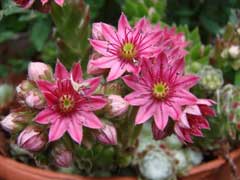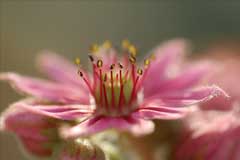 |
|
www.fotopedia.com/items/flickr-559015922 |
 |
| fr.fotopedia.com/items/flickr-3222416238 |
Translate this page:
Summary
Physical Characteristics

 Sempervivum arachnoideum is an evergreen Perennial growing to 0.1 m (0ft 4in) by 0.2 m (0ft 8in).
Sempervivum arachnoideum is an evergreen Perennial growing to 0.1 m (0ft 4in) by 0.2 m (0ft 8in).
See above for USDA hardiness. It is hardy to UK zone 5 and is not frost tender. It is in leaf all year, in flower in July, and the seeds ripen in August. The species is hermaphrodite (has both male and female organs) and is pollinated by Insects.
Suitable for: light (sandy) and medium (loamy) soils and prefers well-drained soil. Suitable pH: mildly acid, neutral and basic (mildly alkaline) soils and can grow in very acid soils.
It cannot grow in the shade. It prefers dry or moist soil and can tolerate drought.
UK Hardiness Map
US Hardiness Map
Synonyms
Plant Habitats
Cultivated Beds; East Wall. In. South Wall. In. West Wall. In.
Edible Uses
References More on Edible Uses
Medicinal Uses
Plants For A Future can not take any responsibility for any adverse effects from the use of plants. Always seek advice from a professional before using a plant medicinally.
Emollient Haemostatic Odontalgic Ophthalmic Sedative Skin
The leaves are emollient, haemostatic, ophthalmic and sedative[7]. The crushed plant, or its juice, is applied externally to boils, wounds etc and is also used to stop nose bleeds[7]. The slightly warmed juice has been used to relieve ear inflammations and toothaches can be relieved by chewing on the leaves[7]. When macerated and infused in vinegar, the plant can be used to get rid of warts and corns[7]. The leaves are harvested in the summer and are best used when fresh since they are difficult to dry properly[7]. The leaf pulp is used to make a cooling face mask for reddened or sunburnt skin[7].
References More on Medicinal Uses
The Bookshop: Edible Plant Books
Our Latest books on Perennial Plants For Food Forests and Permaculture Gardens in paperback or digital formats.

Edible Tropical Plants
Food Forest Plants for Hotter Conditions: 250+ Plants For Tropical Food Forests & Permaculture Gardens.
More

Edible Temperate Plants
Plants for Your Food Forest: 500 Plants for Temperate Food Forests & Permaculture Gardens.
More

More Books
PFAF have eight books available in paperback and digital formats. Browse the shop for more information.
Shop Now
Other Uses
References More on Other Uses
Cultivation details
Prefers a well-drained gritty soil in full sun[200]. Succeeds in any sandy soil, doing well in very little soil in rock crevices, walls, paths etc so long as there is sufficient humus[1, 200]. Prefers growing on acid rocks, though it also succeeds on calcareous ones[219]. Established plants are drought tolerant[200]. Strongly dislikes winter wet[200]. Plants are not very tolerant of weed competition[K]. Polymorphic, this species is split into a number of sub-species by some botanists[200]. Individual rosettes die after flowering, but produce a number of offsets that continue to grow[188]. Hybridizes with a number of other members of this genus[200].
References Carbon Farming Information and Carbon Sequestration Information
Temperature Converter
Type a value in the Celsius field to convert the value to Fahrenheit:
Fahrenheit:
The PFAF Bookshop
Plants For A Future have a number of books available in paperback and digital form. Book titles include Edible Plants, Edible Perennials, Edible Trees,Edible Shrubs, Woodland Gardening, and Temperate Food Forest Plants. Our new book is Food Forest Plants For Hotter Conditions (Tropical and Sub-Tropical).
Shop Now
Plant Propagation
Seed - surface sow in early spring in a cold frame. It usually germinates in 2 - 6 weeks at 10°c. Prick out the seedlings into individual pots when they are large enough to handle and grow them on in the greenhouse for their first winter. Plant them out into their permanent positions in the summer if they have made sufficient growth, otherwise grow them on for a further year in pots before planting them out[K]. Division of offsets in spring or early summer. Larger divisions can be planted out direct into their permanent positions. We have found it best to pot up the smaller divisions and grow them on in a lightly shaded position in a cold frame, planting them out once they are well established in the summer. Plants can also be divided in September but these divisions should be overwintered in a greenhouse. Stem cuttings.
Other Names
If available other names are mentioned here
Native Range
EUROPE: Austria, Switzerland, Germany (south), Italy, Spain, France (incl. Corsica)
Weed Potential
Right plant wrong place. We are currently updating this section.
Please note that a plant may be invasive in one area but may not in your area so it's worth checking.
Conservation Status
IUCN Red List of Threatened Plants Status :

Growth: S = slow M = medium F = fast. Soil: L = light (sandy) M = medium H = heavy (clay). pH: A = acid N = neutral B = basic (alkaline). Shade: F = full shade S = semi-shade N = no shade. Moisture: D = dry M = Moist We = wet Wa = water.
Now available:
Food Forest Plants for Mediterranean Conditions
350+ Perennial Plants For Mediterranean and Drier Food Forests and Permaculture Gardens.
[Paperback and eBook]
This is the third in Plants For A Future's series of plant guides for food forests tailored to
specific climate zones. Following volumes on temperate and tropical ecosystems, this book focuses
on species suited to Mediterranean conditions—regions with hot, dry summers and cool, wet winters,
often facing the added challenge of climate change.
Read More
Expert comment
Author
L.
Botanical References
200
Links / References
For a list of references used on this page please go here
Readers comment
| Add a comment |
|
If you have important information about this plant that may help other users please add a comment or link below. Only comments or links that are felt to be directly relevant to a plant will be included. If you think a comment/link or information contained on this page is inaccurate or misleading we would welcome your feedback at [email protected]. If you have questions about a plant please use the Forum on this website as we do not have the resources to answer questions ourselves.
* Please note: the comments by website users are not necessarily those held by PFAF and may give misleading or inaccurate information.
To leave a comment please Register or login here All comments need to be approved so will not appear immediately.
|
Subject : Sempervivum arachnoideum
|
|
|
|